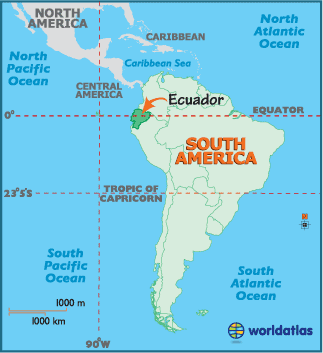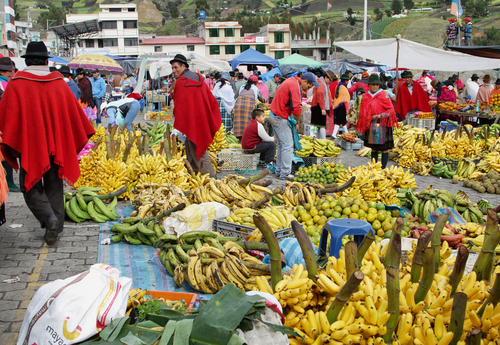Last updated on October 28th, 2022
Ecuador is home to a wide variety of scenic and environmental wonders. From the Amazonian rainforest to the tops of the Andes Mountains; and the coastal towns to the Galapagos Islands, there are sights and experiences that are sure to impress. With these 44 facts about Ecuador; let’s gather more information about its history, culture, tradition, economy, food, tourism, people, and more…
Ecuador’s History
1. Before the Incas created settlements in Ecuador, it was inhabited by its Native American peoples.
2. Ecuador was founded in 1532 by the Spanish, who drove out the Incans to claim it.
3. Ruled for 300 years from Peru and then by Spanish governors from Colombia, these Spaniards brought to Ecuador their religion, language and architecture. In 1822, this era ended with the achievement of independence. They first declared independence on August 10, 1809; they finally achieved it from Spain on May 24, 1822.
4. Simon Bolivar united Ecuador to the territories of what are today Panama, Venezuela, and Colombia to form what was called The Gran Colombia (1819-30). This short-lived country collapsed in 1830 and three separate countries were created from it: Ecuador, Venezuela, and Colombia (which included what later became Panama).
5. Ecuador was named after the equator which runs through the country, the only country in the world named after a geographical feature. Its official name, República del Ecuador, literally means “the Republic of the Equator”.

6. Ecuador and Peru battled over control of Ecuador’s Amazon territories for well over a century, in what became the Western Hemisphere’s longest-running dispute over territory. It ended in May of 1999 with both countries signing an agreement.
7. As the country became a republic, many coup d’état and dictatorships have been part of the country’s more recent history. It has had 48 presidents in its first 131 years of independence.
8. The world’s very first and second UNESCO World Heritage Sites are in Ecuador. The Galápagos Islands is site number one and the capital city of Quito is site number two. These were named at the inaugural World Heritage conference in 1978. See the full list here.
9. In spite its border conflicts, Ecuador has been peaceful in recent years. Presently it is one of the safest South American countries to visit.
10. Ecuador is one of only two South American countries that do not share a border with Brazil.
Ecuador on the map
Facts about Ecuador’s economy, food, and tourism
11. Ecuador is divided into four main and unique geographic regions that have their own diets and contribute to the country’s economy in different ways, according to the natural resources found there. These are the coastal lowlands (La Costa), the mountain highlands (La Sierra); the eastern jungle lowlands (La Amazonia or El Oriente “the east”); and the Galápagos Islands (La Región Insular).
12. Ecuador is the world’s largest exporter of bananas, exporting 2.7 billion worth of them annually.
13. Crude oil and related products accounts for 58 percent of Ecuador’s exports.
14. Ecuador provides the majority of the world’s balsa wood. The country also exports coffee and flowers.
15. Ecuador has used the American Dollar as its national currency since 2000.
16. Cuy, or guinea pig, is considered a delicacy in the country. It is roasted whole and its consumption is an ancient tradition. It is said to taste like rabbit.
17. There is no national food as cuisine varies from region to region. Costeños who live in the La Costa region, favor fish, plantains, and beans. Serranos (from La Sierra region) prefer meat, white hominy, and rice.
18. Ecuador is the 9th most biodiverse country in the world and offers much for visitors to see and do.
You may like: 34 Interesting facts about Bolivia
Facts about Ecuadorian culture and customs

19. More than 70 percent of Ecuador’s population is made up of Mestizos (an ethnic blend of Spaniards and native people) and the rest includes a significant population of indigenous peoples.
20. Spanish is Ecuador’s official language but there are 13 recognized indigenous languages that are also spoken.
21. Several native inland Amazonian tribes managed to avoid both Incan and Spanish conquest. They have preserved their ancient cultural traditions independently of foreign influence.
22. Families may be formed through two different methods. Civil marriage is the legally binding bond between a man and a woman. All married couples are required to undergo the legal ceremony. The other method is Free Union, in which a couple decides to form a family without first undergoing any official service. Both types of unions grant families the same rights and duties.
23. If you need health care, you have no worries. Ecuador’s Healthcare System is ranked 20th in the world for quality.
24. Voting is not just a right in Ecuador; it is compulsory for all citizens between the ages of 18 and 65.
25. Children are required to attend school until they have achieved a “basic education”. According to the Ministry of Education, this is typically for 6 years. Only about 10 percent of all rural students attend high school.
26. Ecuador music is known as Pasillo and is played for dances and festivals, as well as for when men and women in traditional dress perform to the music.
27. Kichwa people of Tigua (in the central Sierra region) are known world-wide for their carefully done traditional paintings on sheepskin canvases. Tigua artists use simple themes with vibrant colors in their work.
Flag of Ecuador

28. The three colors of the Ecuadorian flag are yellow for the country’s diversity, blue for its sea and sky, and red for the blood of the fighters who won their independence.
Ecuador Facts for Kids
29. At the Ciudad Mitad del Mundo (Middle of the World City) is a marked line where you can stand with one foot in the Northern Hemisphere and the other foot in the Southern Hemisphere. Unfortunately, this tourist destination 26 kilometers (16 miles) north of Quito, the national capital, needs some updating. Thanks to new and more precise re-measurements, the exact position of the equator is now said to lie 240 meters (262.5 yards) north of the monument and its marked line!

30. Charles Darwin made his famous Voyage of the USS Beagle to the Galápagos Islands in 1835. He based his theory of evolution largely on the discoveries and observations he made in the islands.
31. Ecuador’s Cotopaxi is the highest active volcano in the world.
32. Chimborazo’s summit is the point on earth closest to the sun and the farthest from the core of the earth, due to the earth’s slide bulge there. This also means that Ecuador is the closest country on earth to outer space.
33. Ecuador sees very little change in the length of its days from winter to summer due to its location on the equator. Sunrise and sunset happen every day at around 6:00 am and pm, respectively.
Related: Nicaragua facts
Interesting facts about Ecuador
34. The cinchona tree is Ecuador’s national tree. This tree produces Quinine, which was the first drug ever used to treat and prevent malaria.

35. The famous Panama Hat is actually made in Ecuador. Craftsmen on the coast wove straw hats that were taken to Panama to be sold to protect canal workers from the sun. After the canal was complete, they were sold to the affluent Westerners who traveled through the Canal.
36. Ecuador was the first nation to ever declare that nature has constitutional rights. In 2008 Ecuador recognized that nature has the “right to exist, persist….and regenerate its vital cycles’, and therefore has constitutional rights. Nature should not be treated as property.
37. Ecuador has one of the greatest densities of volcanoes on earth. Ecuador was the first country in the history of the world to eliminate the death penalty. They waived it in 1906.
38. Ecuador maintains a scientific research station in Antarctica. The Antarctica Treaty designated this continent be set aside for research and not for ownership, and Ecuador in a part of that treaty.
. . . continue reading on the next page
